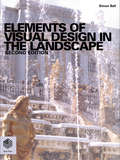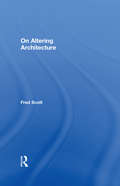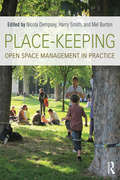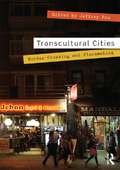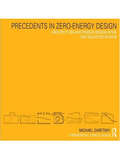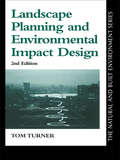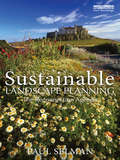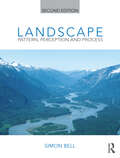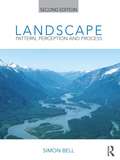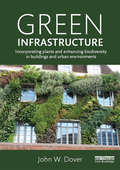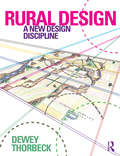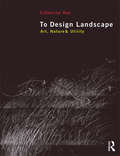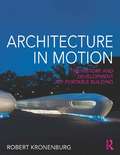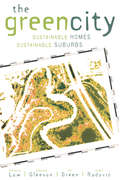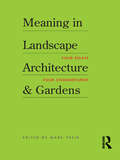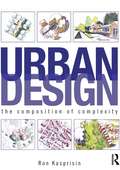- Table View
- List View
Elements of Visual Design in the Landscape
by Simon BellPublic concern about the landscape, in particular its appearance, is increasing all the time. For those charged with managing, developing or conserving a wide range of landscapes it is a major task to take visual aspects into account. Elements of Visual Design in the Landsacpe presents a vocabulary of visual design, structured in a logical and easy to follow sequence. It is profusely illustrated using both abstract and real examples taken from a wide range of international locations together with cross referencing between related principles and case studies demonstrating how the principles can be applied in practice. The visual aspects of design have often been treated as 'cosmetic' and therefore not meriting attention or purely subjective and therefore open to personal preference. Few attempts have been made to explain how we see the landscape in any rational and structured way, and to demonstrate how visually creative design and management can be undertaken. This book aims to fill that gap.
On Altering Architecture
by Fred ScottBringing together interior design and architectural theory, this exciting text looks at the common practices of building alteration, reconsidering established ideas and methods, to initiate the creation of a theory of the interior or interventional design. Fred Scott examines in-depth case studies of interventional design from architectural history across the world – examples discussed are taken from the States, Europe and Japan. Scott expands and builds on the ideas of Viollet-le-Duc, structuralism and other thoughts to layout criteria for an art of intervention and change. The book draws on the philosophy of conservation, preservation and restoration, as well as exploring related social and political issues. For those in professions of architecture and interiors, town planners, and students in architecture and art schools, On Altering Architecture forms a body of thought that can be aligned and compared with architectural theory.
On Altering Architecture
by Fred ScottBringing together interior design and architectural theory, this exciting text looks at the common practices of building alteration, reconsidering established ideas and methods, to initiate the creation of a theory of the interior or interventional design. Fred Scott examines in-depth case studies of interventional design from architectural history across the world – examples discussed are taken from the States, Europe and Japan. Scott expands and builds on the ideas of Viollet-le-Duc, structuralism and other thoughts to layout criteria for an art of intervention and change. The book draws on the philosophy of conservation, preservation and restoration, as well as exploring related social and political issues. For those in professions of architecture and interiors, town planners, and students in architecture and art schools, On Altering Architecture forms a body of thought that can be aligned and compared with architectural theory.
Place-Keeping: Open Space Management in Practice
by Nicola Dempsey Harry Smith Mel BurtonPlace-Keeping presents the latest research and practice on place-keeping – that is, the long-term management of public and private open spaces – from around Europe and the rest of the world. There has long been a focus in urban landscape planning and urban design on the creation of high-quality public spaces, or place-making. This is supported by a growing body of research which shows how high-quality public spaces are economically and socially beneficial for local communities and contribute positively to residents’ quality of life and wellbeing. However, while large amounts of capital are spent on the creation of open spaces, little thought is given to, and insufficient resources made available for, the long-term maintenance and management of public spaces, or place-keeping. Without place-keeping, public spaces can fall into a downward spiral of disrepair where anti-social behaviour can emerge and residents may feel unsafe and choose to use other spaces. The economic and social costs of restoring such spaces can therefore be considerable where place-keeping does not occur. Place-Keeping also provides an accessible presentation of the outputs of a major European Union-funded project MP4: Making Places Profitable, Public and Private Open Spaces which further extends the knowledge and debate on long-term management of public and private spaces. It will be an invaluable resource for students, academics and practitioners seeking critical but practical guidance on the long-term management of public and private spaces in a range of contexts.
Place-Keeping: Open Space Management in Practice
by Nicola Dempsey Harry Smith Mel BurtonPlace-Keeping presents the latest research and practice on place-keeping – that is, the long-term management of public and private open spaces – from around Europe and the rest of the world. There has long been a focus in urban landscape planning and urban design on the creation of high-quality public spaces, or place-making. This is supported by a growing body of research which shows how high-quality public spaces are economically and socially beneficial for local communities and contribute positively to residents’ quality of life and wellbeing. However, while large amounts of capital are spent on the creation of open spaces, little thought is given to, and insufficient resources made available for, the long-term maintenance and management of public spaces, or place-keeping. Without place-keeping, public spaces can fall into a downward spiral of disrepair where anti-social behaviour can emerge and residents may feel unsafe and choose to use other spaces. The economic and social costs of restoring such spaces can therefore be considerable where place-keeping does not occur. Place-Keeping also provides an accessible presentation of the outputs of a major European Union-funded project MP4: Making Places Profitable, Public and Private Open Spaces which further extends the knowledge and debate on long-term management of public and private spaces. It will be an invaluable resource for students, academics and practitioners seeking critical but practical guidance on the long-term management of public and private spaces in a range of contexts.
Transcultural Cities: Border-Crossing and Placemaking
by Jeffrey HouTranscultural Cities uses a framework of transcultural placemaking, cross-disciplinary inquiry and transnational focus to examine a collection of case studies around the world, presented by a multidisciplinary group of scholars and activists in architecture, urban planning, urban studies, art, environmental psychology, geography, political science, and social work. The book addresses the intercultural exchanges as well as the cultural trans-formation that takes place in urban spaces. In doing so, it views cultures not in isolation from each other in today’s diverse urban environments, but as mutually influenced, constituted and transformed. In cities and regions around the globe, migrations of people have continued to shape the makeup and making of neighborhoods, districts, and communities. For instance, in North America, new immigrants have revitalized many of the decaying urban landscapes, creating renewed cultural ambiance and economic networks that transcend borders. In Richmond, BC Canada, an Asian night market has become a major cultural event that draws visitors throughout the region and across the US and Canadian border. Across the Pacific, foreign domestic workers in Hong Kong transform the deserted office district in Central on weekends into a carnivalesque site. While contributing to the multicultural vibes in cities, migration and movements have also resulted in tensions, competition, and clashes of cultures between different ethnic communities, old-timers, newcomers, employees and employers, individuals and institutions. In Transcultural Cities Jeffrey Hou and a cross-disciplinary team of authors argue for a more critical and open approach that sees today’s cities, urban places, and placemaking as vehicles for cross-cultural understanding.
Transcultural Cities: Border-Crossing and Placemaking
by Jeffrey HouTranscultural Cities uses a framework of transcultural placemaking, cross-disciplinary inquiry and transnational focus to examine a collection of case studies around the world, presented by a multidisciplinary group of scholars and activists in architecture, urban planning, urban studies, art, environmental psychology, geography, political science, and social work. The book addresses the intercultural exchanges as well as the cultural trans-formation that takes place in urban spaces. In doing so, it views cultures not in isolation from each other in today’s diverse urban environments, but as mutually influenced, constituted and transformed. In cities and regions around the globe, migrations of people have continued to shape the makeup and making of neighborhoods, districts, and communities. For instance, in North America, new immigrants have revitalized many of the decaying urban landscapes, creating renewed cultural ambiance and economic networks that transcend borders. In Richmond, BC Canada, an Asian night market has become a major cultural event that draws visitors throughout the region and across the US and Canadian border. Across the Pacific, foreign domestic workers in Hong Kong transform the deserted office district in Central on weekends into a carnivalesque site. While contributing to the multicultural vibes in cities, migration and movements have also resulted in tensions, competition, and clashes of cultures between different ethnic communities, old-timers, newcomers, employees and employers, individuals and institutions. In Transcultural Cities Jeffrey Hou and a cross-disciplinary team of authors argue for a more critical and open approach that sees today’s cities, urban places, and placemaking as vehicles for cross-cultural understanding.
Precedents in Zero-Energy Design: Architecture and Passive Design in the 2007 Solar Decathlon
by Michael Zaretsky‘Michael Zaretsky’s Precedents in Zero-Energy Design is such an important book … it will help readers recognize that design comes before technology – and renewable energy systems alone can’t solve the problems we face’ – John D. Quale, Assistant Professor of Architecture and ecoMOD Project Director, University of Virginia The world is currently facing an environmental crisis and as anyone interested in sustainable or zero-energy design knows the design and building industries have the potential to significantly reduce greenhouse gas emissions across the globe. The Solar Decathlon is an international event in which universities from around the world compete in the design and construction of a one-bedroom, zero-energy house. This book provides an in-depth, yet accessible analysis of the architecture and passive design strategies of the houses in the 2007 Solar Decathlon. These houses are the result of thousands of hours of research and development from twenty universities around the world. Divided into three parts, the book provides: an initial section investigating the architecture, passive design and systems layout of the twenty houses; a diagrammatic comparison of the architecture and passive design characteristics of each of the twenty houses in order of ranking by the Architecture, Comfort Zone and overall scores received in the competition; a deep analysis of the relationship between architecture, passive design and mechanical systems design as compared to the rankings received in the various contests. This analysis considers the decisions made by the competing teams and highlights the success of the design strategies employed. Students, educators, practitioners and researchers of architecture, design and engineering will find this an informative and inspirational book. It examines the relationship between design and environmental principles and provides invaluable insight into some of the most innovative, off-the-grid and zero-energy houses in the world. With a Foreword by John D. Quale, Assistant Professor of Architecture and ecoMOD Project Director, University of Virginia
Landscape Planning And Environmental Impact Design
by Tom TurnerWritten for use in undergraduate and postgraduate planning courses and for those involved in all aspects of the planning process, this comprehensive textbook focuses on environmental impact assessment and design and in particular their impact on planning for the landscape.
Landscape Planning And Environmental Impact Design
by Tom TurnerWritten for use in undergraduate and postgraduate planning courses and for those involved in all aspects of the planning process, this comprehensive textbook focuses on environmental impact assessment and design and in particular their impact on planning for the landscape.
Sustainable Landscape Planning: The Reconnection Agenda
by Paul SelmanThis book takes as its starting point the need to examine critically the case for landscape reconnection. It looks at alleged disconnections and their supposed consequences. It explores the arguments about reconnecting the natural and human elements of whole landscapes. More broadly, it considers landscape as an arena within which science, humanities and professions can find common ground, and in which vivid social learning can occur about key social and environmental issues. It takes a dynamic view of landscape, in contrast to the popular image of timeless, traditional scenery. It accepts that even the most cherished cultural landscapes will change and, indeed, it views ‘change drivers’ as a potentially positive means of creating new connectivities between people and place. It recognises the growing interest in promoting resilience and ecosystem services across extensive landscapes - such as by creating new 'space' for water and wildlife. ?
Sustainable Landscape Planning: The Reconnection Agenda
by Paul SelmanThis book takes as its starting point the need to examine critically the case for landscape reconnection. It looks at alleged disconnections and their supposed consequences. It explores the arguments about reconnecting the natural and human elements of whole landscapes. More broadly, it considers landscape as an arena within which science, humanities and professions can find common ground, and in which vivid social learning can occur about key social and environmental issues. It takes a dynamic view of landscape, in contrast to the popular image of timeless, traditional scenery. It accepts that even the most cherished cultural landscapes will change and, indeed, it views ‘change drivers’ as a potentially positive means of creating new connectivities between people and place. It recognises the growing interest in promoting resilience and ecosystem services across extensive landscapes - such as by creating new 'space' for water and wildlife. ?
Landscape: Pattern, Perception and Process
by Simon BellLandscapes develop and evolve through an interacting series of processes – climatic, geological, ecological and cultural – over varying periods of time. These processes shape the structure and character of the landscapes which we experience. Over time, distinctive patterns emerge – ranging in scale from the distribution of small plants to the sculptured sides of a huge canyon. Our perception of these patterns goes beyond just their visual appreciation – beautiful though they may be – into a richer understanding of how we experience our environment. By understanding this complex pattern–process interaction we can obtain a deeper awareness of landscape and our place in it – as inhabitants and as shapers. The book explores the nature of patterns and ways of classifying them before studying the nature of perception (primarily visual but including other senses), then proceeds to relate this perception to aesthetics and from there to the design process. From this point the main driving processes in landscape are introduced alongside the resulting patterns, these being climatic, landform, ecosystem and cultural aspects. It is this integrative approach of looking at landscape as a kind of self-organising system, overlaid by conscious human planning activities and the unity of pattern and process, which makes this book unique. Landscape draws from a wide range of neighbouring disciplines, of which the landscape planner or designer needs to be aware, but which are often taught as distinct elements. Bell binds these fundamentals together, which enables the landscape to be ‘read’, and this reading to be used as the basis for planning and design. This second edition updates and refreshes the original material with added sections and new photos, particularly making use of the developments in satellite photography. Featuring full colour throughout, this textbook is ideal for anyone studying landscape architecture or any of the disciplines which intersect with the landscape, and which affect it.
Landscape: Pattern, Perception and Process
by Simon BellLandscapes develop and evolve through an interacting series of processes – climatic, geological, ecological and cultural – over varying periods of time. These processes shape the structure and character of the landscapes which we experience. Over time, distinctive patterns emerge – ranging in scale from the distribution of small plants to the sculptured sides of a huge canyon. Our perception of these patterns goes beyond just their visual appreciation – beautiful though they may be – into a richer understanding of how we experience our environment. By understanding this complex pattern–process interaction we can obtain a deeper awareness of landscape and our place in it – as inhabitants and as shapers. The book explores the nature of patterns and ways of classifying them before studying the nature of perception (primarily visual but including other senses), then proceeds to relate this perception to aesthetics and from there to the design process. From this point the main driving processes in landscape are introduced alongside the resulting patterns, these being climatic, landform, ecosystem and cultural aspects. It is this integrative approach of looking at landscape as a kind of self-organising system, overlaid by conscious human planning activities and the unity of pattern and process, which makes this book unique. Landscape draws from a wide range of neighbouring disciplines, of which the landscape planner or designer needs to be aware, but which are often taught as distinct elements. Bell binds these fundamentals together, which enables the landscape to be ‘read’, and this reading to be used as the basis for planning and design. This second edition updates and refreshes the original material with added sections and new photos, particularly making use of the developments in satellite photography. Featuring full colour throughout, this textbook is ideal for anyone studying landscape architecture or any of the disciplines which intersect with the landscape, and which affect it.
Green Infrastructure: Incorporating Plants and Enhancing Biodiversity in Buildings and Urban Environments (Routledge Studies in Urban Ecology)
by John W. DoverWith more than half of the world's population now living in urban areas, it is vitally important that towns and cities are healthy places to live. The principal aim of this book is to synthesize the disparate literature on the use of vegetation in the built environment and its multifunctional benefits to humans. The author reviews issues such as: contact with wildlife and its immediate and long-term effects on psychological and physical wellbeing; the role of vegetation in removing health-damaging pollutants from the air; green roofs and green walls, which provide insulation, reduce energy use and decrease the carbon footprint of buildings; and structural vegetation such as street trees, providing shading and air circulation whilst also helping to stop flash-floods through surface drainage. Examples are used throughout to illustrate the practical use of vegetation to improve the urban environment and deliver ecosystem services. Whilst the underlying theme is the value of biodiversity, the emphasis is less on existing high-value green spaces (such as nature reserves, parks and gardens), than on the sealed surfaces of urban areas (building surfaces, roads, car parks, plazas, etc.). The book shows how these, and the spaces they encapsulate, can be modified to meet current and future environmental challenges including climate change. The value of existing green space is also covered to provide a comprehensive textbook of international relevance.
Rural Design: A New Design Discipline
by Dewey ThorbeckRural areas worldwide are undergoing profound change creating considerable challenges and stress for its residents and on the ecosystems upon which they depend. Rural design brings design thinking and the problem-solving process of design to rural issues recognizing that human and natural systems are inextricably coupled and engaged in continuous cycles of mutual influence and response. This book is the first step along the path for rural design to emerge as an important new design discipline. Rural Design: A New Design Discipline establishes the theoretical base for rural design and the importance of looking at connecting issues to create synergy and optimal solutions from a global, national, state, region, and local perspective. To be effective and relevant, this new discipline must be founded on solid research, and practice must be based on data-driven evidence that will result in transformational changes. These directions and others will enable rural design to: help rural communities make land use, architectural, and aesthetic decisions that enhance their quality of life and the environment connect social, artistic, cultural, technological, and environmental issues that create rural place promote sustainable economic development for rural communities and improve human, livestock, crop, and ecosystem health and integrate research and practice across the many disciplines involved in rural issues to meet rural needs, provide new data, and provoke new research questions. Written by a world leading expert in rural design, who is director and founder of the University of Minnesota Center for Rural Design, the book is oriented toward students, academics and design professionals involved with rural design at any level.
Rural Design: A New Design Discipline
by Dewey ThorbeckRural areas worldwide are undergoing profound change creating considerable challenges and stress for its residents and on the ecosystems upon which they depend. Rural design brings design thinking and the problem-solving process of design to rural issues recognizing that human and natural systems are inextricably coupled and engaged in continuous cycles of mutual influence and response. This book is the first step along the path for rural design to emerge as an important new design discipline. Rural Design: A New Design Discipline establishes the theoretical base for rural design and the importance of looking at connecting issues to create synergy and optimal solutions from a global, national, state, region, and local perspective. To be effective and relevant, this new discipline must be founded on solid research, and practice must be based on data-driven evidence that will result in transformational changes. These directions and others will enable rural design to: help rural communities make land use, architectural, and aesthetic decisions that enhance their quality of life and the environment connect social, artistic, cultural, technological, and environmental issues that create rural place promote sustainable economic development for rural communities and improve human, livestock, crop, and ecosystem health and integrate research and practice across the many disciplines involved in rural issues to meet rural needs, provide new data, and provoke new research questions. Written by a world leading expert in rural design, who is director and founder of the University of Minnesota Center for Rural Design, the book is oriented toward students, academics and design professionals involved with rural design at any level.
To Design Landscape: Art, Nature & Utility
by Catherine DeeTo Design Landscape sets out a distinctively practical philosophy of design, in accessible format. Based on the notion that landscape design is a form-based craft addressing environmental processes and utility, Dee establishes a framework for approaching such craft with modesty and ingenuity, using the concept of "aesthetics of thrift".Employing numerous case studies-as diverse as Hellerup Rose Garden in Denmark; Bloedel Reserve, Bainbridge Island, USA; Rousham Gardens, Oxfordshire, UK and Tofuku-ji, in Kyoto, Japan - to illustrate her ideas, the book is a beautiful portfolio of Dee's drawings, which are both evocative and to the point.The book begins with a 'Foundations' section, which sets out the basis of the approach. ?'Principles' chapters then elaborate eleven significant considerations applicable to any design project, regardless of context and scale. Following on, 'Strategies' chapters reinforce the principles, and suggest further ways of designing, adaptable to different conditions. Dee ends with a focus on 'Elements', case studies and verb lists providing sources for the designer to consider how the components - vegetation, water, terrain, structures, soils, weather, and the sky - ?might be engaged, mediated and joined.Catherine Dee’s book is for all those who would craft landscape, from the gardener, to the professional landscape architect, to the student of design
To Design Landscape: Art, Nature & Utility
by Catherine DeeTo Design Landscape sets out a distinctively practical philosophy of design, in accessible format. Based on the notion that landscape design is a form-based craft addressing environmental processes and utility, Dee establishes a framework for approaching such craft with modesty and ingenuity, using the concept of "aesthetics of thrift".Employing numerous case studies-as diverse as Hellerup Rose Garden in Denmark; Bloedel Reserve, Bainbridge Island, USA; Rousham Gardens, Oxfordshire, UK and Tofuku-ji, in Kyoto, Japan - to illustrate her ideas, the book is a beautiful portfolio of Dee's drawings, which are both evocative and to the point.The book begins with a 'Foundations' section, which sets out the basis of the approach. ?'Principles' chapters then elaborate eleven significant considerations applicable to any design project, regardless of context and scale. Following on, 'Strategies' chapters reinforce the principles, and suggest further ways of designing, adaptable to different conditions. Dee ends with a focus on 'Elements', case studies and verb lists providing sources for the designer to consider how the components - vegetation, water, terrain, structures, soils, weather, and the sky - ?might be engaged, mediated and joined.Catherine Dee’s book is for all those who would craft landscape, from the gardener, to the professional landscape architect, to the student of design
Architecture in Motion: The history and development of portable building
by Robert KronenburgThe idea that architecture can be portable is one that grabs the imagination of both designers and the people who use it, perhaps because it so often forecasts a dynamic and creative solution to the complex problems of our contemporary mobile society, while at the same time dealing with issues of practicality, economy and sustainability. Architecture in Motion examines the development of portable, transportable, demountable and temporary architecture from prehistory to the present day. From familiar vernacular models such as the tent, mobile home and houseboat, to ambitious developments in military and construction engineering, all aspects of portable building are considered. Building on his earlier works Portable Architecture and Houses in Motion, Robert Kronenburg compares traditional forms of building, current commercial products and the work of innovative designers, and examines key contemporary portable buildings to reveal surprising, exciting and imaginative examples. He explores the philosophical and technological issues raised by these experimental and futuristic prototypes. By understanding the nature of transitory architecture, a new ecologically aware design strategy can be developed to prioritise buildings that 'tread lightly on the earth' and still convey the sense of identity and community necessary for an established responsible society. This book provides a unique insight into this pivotal field of design.
Architecture in Motion: The history and development of portable building
by Robert KronenburgThe idea that architecture can be portable is one that grabs the imagination of both designers and the people who use it, perhaps because it so often forecasts a dynamic and creative solution to the complex problems of our contemporary mobile society, while at the same time dealing with issues of practicality, economy and sustainability. Architecture in Motion examines the development of portable, transportable, demountable and temporary architecture from prehistory to the present day. From familiar vernacular models such as the tent, mobile home and houseboat, to ambitious developments in military and construction engineering, all aspects of portable building are considered. Building on his earlier works Portable Architecture and Houses in Motion, Robert Kronenburg compares traditional forms of building, current commercial products and the work of innovative designers, and examines key contemporary portable buildings to reveal surprising, exciting and imaginative examples. He explores the philosophical and technological issues raised by these experimental and futuristic prototypes. By understanding the nature of transitory architecture, a new ecologically aware design strategy can be developed to prioritise buildings that 'tread lightly on the earth' and still convey the sense of identity and community necessary for an established responsible society. This book provides a unique insight into this pivotal field of design.
The Green City: Sustainable Homes, Sustainable Suburbs
by Nicholas Low Brendon Gleeson Ray Green Darko RadovicA team of city-building professionals explain in straightforward terms how the idea of ecological sustainability can be embodied in the everyday life of homes, communities and cities to make a better future.The book considers - and answers - three questions: What does the global agenda of sustainable development mean for the urban spaces where most people live, work and move? Can we keep what we love about suburban life and still save the environment? And what new methods of planning and building will be needed in the 21st century? Rejecting both economic and environmental orthodoxy, the book’s essential message is that the sustainable city can be built by a thousand well-directed small changes. It draws on practical case material from around the world and weaves together four critical aspects of urban life: housing, open space, workplaces and transport. A 'photographic essay' of 32 colour plates illustrates the ideas discussed.
Meaning in Landscape Architecture and Gardens
by Marc TreibWhile we all live our lives in designed landscapes of various types, only on occasion do we consider what these landscapes mean to us and how they have acquired that significance. Can a landscape architect or garden designer really imbue new settings with meaning, or does meaning evolve over time, created by those who perceive and use these landscapes? What role does the selection and arrangement of plants and hard materials play in this process and just where does the passage of time enter into the equation? These questions collectively provide the core material for Meaning in Landscape Architecture and Gardens, a compendium of four landmark essays written over a period of twenty years by leading scholars in the field of landscape architecture. New commentaries by the authors accompany each of the essays and reflect on the thinking behind them as well as the evolution of the author’s thoughts since their original publication. Although the central theme of these writings is landscape architecture broadly taken, the principal subject of several essays and commentaries is the garden, a subject historically plentiful in allusions and metaphors. As a whole Meaning in Landscape Architecture and Gardens offers the general reader as well as the professional a rich source of ideas about the designed landscape and the ways by which we perceive, consider, react, and dwell within them – and what they mean to us. The essays have been perennial favorites in landscape courses since their original publication in Landscape Journal. Bringing them together – bolstered by the new commentaries – creates a book valuable to all those creating gardens and landscapes, as well as those teaching and studying these subjects.
Urban Design: The Composition of Complexity
by Ron KasprisinFor planning to be successful, design must mean more than simply blindly following the dictates of legislation and regulation – yet losing sight of the importance of the design process is all too often exactly what has happened. Ron Kasprisin has written a book for students of planning and urban design that reconnects the process of designing with outcomes on the ground, and puts thinking about design back at the heart of what planners do. The book identifies the elements and principles of composition and explores compositional order and structure as they relate to the meaning and functionality of cities. It discusses new directions and methods, outlines the importance of both buildings and the open spaces between them. Mixing accessible theory, practical examples and carefully designed exercises in composition from simple to complex settings, Urban Design is an essential textbook for classrooms and design studios across the full spectrum of planning and urban studies fields. Not only filled with illustrations and graphics of excellent projects, it gives students tools to enable them to sketch, draw, design and above all, to think.
Urban Design: The Composition of Complexity
by Ron KasprisinFor planning to be successful, design must mean more than simply blindly following the dictates of legislation and regulation – yet losing sight of the importance of the design process is all too often exactly what has happened. Ron Kasprisin has written a book for students of planning and urban design that reconnects the process of designing with outcomes on the ground, and puts thinking about design back at the heart of what planners do. The book identifies the elements and principles of composition and explores compositional order and structure as they relate to the meaning and functionality of cities. It discusses new directions and methods, outlines the importance of both buildings and the open spaces between them. Mixing accessible theory, practical examples and carefully designed exercises in composition from simple to complex settings, Urban Design is an essential textbook for classrooms and design studios across the full spectrum of planning and urban studies fields. Not only filled with illustrations and graphics of excellent projects, it gives students tools to enable them to sketch, draw, design and above all, to think.
